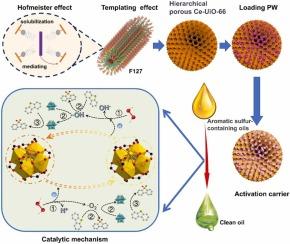缺陷分级多孔Ce-UiO-66激发磷钨酸进行低温氧化脱硫
IF 11.3
1区 环境科学与生态学
Q1 ENGINEERING, ENVIRONMENTAL
引用次数: 0
摘要
金属有机骨架(MOFs)作为氧化脱硫(ODS)的主客体催化剂,由于其微孔结构限制了其进入活性位点的能力,因此面临着挑战。本文通过模板法在水环境中合成了层次化多孔Ce-UiO-66 (HCU),以增强宿主的可达性;磷钨酸(PW)通过后浸渍在HCU介孔内均匀加载;通过酸后处理选择性去除HCU中的配位乙酸,暴露Ce位点,协同优化了复合材料的催化电位。所得HCU@5PW-H在温和条件(40°C, O/S摩尔比= 5)下,在16分钟内具有出色的脱硫性能(1000ppm脱硫),并且在至少8次循环中保持高效率。其催化机制包括H2O2分解为活性氧(ROS),并形成决定ODS活性的wvi -过氧化物中间体。这种协同机制为在温和条件下提高分层多孔mof基主客体催化剂的氧化电位提供了一种有希望的策略。本文章由计算机程序翻译,如有差异,请以英文原文为准。

Defective hierarchical porous Ce-UiO-66 excites phosphotungstic acid for superior low-temperature oxidative desulfurization
Metal-organic frameworks (MOFs) as host-guest catalyst in oxidative desulfurization (ODS) face challenges due to limited access to active sites through their microporosity. Herein, hierarchical porous Ce-UiO-66 (HCU) was synthesized through a templating method in an aqueous environment to enhance host accessibility; phosphotungstic acid (PW) was uniformly loaded within the mesopores of HCU via post-impregnation; Ce sites were exposed by selective removing the coordinated acetate from the HCU with the acid post-treatment, these synergistically optimized the catalytic potential of the composite. The resulting HCU@5PW-H demonstrates outstanding desulfurization performance (1000 ppm sulfur removal) within 16 minutes under mild conditions (40 °C, O/S molar ratio = 5) and maintains high efficiency over at least eight cycles. The catalytic mechanism involves the decomposition of H2O2 to reactive oxygen species (ROS) and the formation of WVI-peroxo intermediates that determine the ODS activity. This synergistic mechanism offers a promising strategy to enhance the oxidation potential of hierarchical porous MOF-based host-guest catalysts under mild conditions.
求助全文
通过发布文献求助,成功后即可免费获取论文全文。
去求助
来源期刊

Journal of Hazardous Materials
工程技术-工程:环境
CiteScore
25.40
自引率
5.90%
发文量
3059
审稿时长
58 days
期刊介绍:
The Journal of Hazardous Materials serves as a global platform for promoting cutting-edge research in the field of Environmental Science and Engineering. Our publication features a wide range of articles, including full-length research papers, review articles, and perspectives, with the aim of enhancing our understanding of the dangers and risks associated with various materials concerning public health and the environment. It is important to note that the term "environmental contaminants" refers specifically to substances that pose hazardous effects through contamination, while excluding those that do not have such impacts on the environment or human health. Moreover, we emphasize the distinction between wastes and hazardous materials in order to provide further clarity on the scope of the journal. We have a keen interest in exploring specific compounds and microbial agents that have adverse effects on the environment.
 求助内容:
求助内容: 应助结果提醒方式:
应助结果提醒方式:


